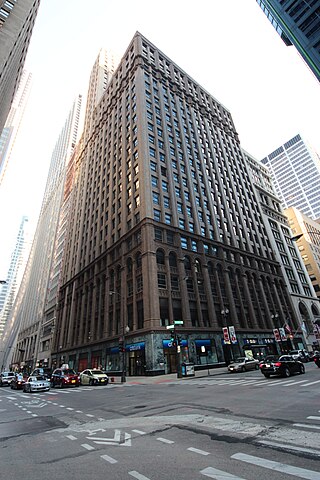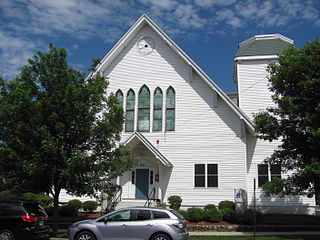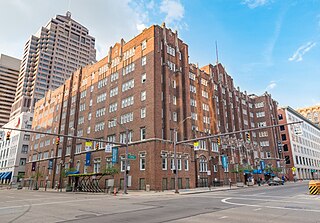
The Chicago Board of Trade Building is a 44-story, 604-foot (184 m) Art Deco skyscraper located in the Chicago Loop, standing at the foot of the LaSalle Street canyon. Built in 1930 for the Chicago Board of Trade (CBOT), it has served as the primary trading venue of the CBOT and later the CME Group, formed in 2007 by the merger of the CBOT and the Chicago Mercantile Exchange. In 2012, the CME Group sold the CBOT Building to a consortium of real estate investors, including GlenStar Properties LLC and USAA Real Estate Company.

The One North LaSalle Building or One LaSalle Street Building is a building in the LaSalle Street corridor in the Loop community area of Chicago managed by MB Real Estate. It was for some time one of Chicago's tallest buildings. Built in 1930 by architects Vitzthum & Burns, it replaces the Tacoma Building by Holabird & Roche. The building is located across Madison Street from Roanoke Building. It was designated a Chicago Landmark on April 16, 1996, and added to the National Register of Historic Places on November 22, 1999. Its 5th floor relief panels depict the explorations of René-Robert Cavelier, Sieur de La Salle.

11 South LaSalle Street Building or Eleven South LaSalle Street Building is a Chicago Landmark building that is listed on the National Register of Historic Places and that is located at 11 South LaSalle Street in the Loop community area of Chicago, Illinois, United States. This address is located on the southeast corner of LaSalle and Madison Street in Cook County, Illinois, across the Madison Street from the One North LaSalle Building. The building sits on a site of a former Roanoke building that once served as a National Weather Service Weather Forecast official climate site and replaced Major Block 1 after the Great Chicago Fire. The current building has incorporated the frontage of other buildings east of the original site of Major Block 1.

The Church of St. Wenceslaus is a Catholic church in New Prague, Minnesota, United States, constructed in 1907. The church is flanked by a 1908 rectory and a 1914 parochial school, and the three-building complex is listed on the National Register of Historic Places for its association with the Czech American settlement of south-central Minnesota.

The Lynn Masonic Hall is a historic Masonic building located at 64-68 Market Street in Lynn, Massachusetts. The four story brick building was built in 1880 for the Lynn branch of YMCA. It is one of two surviving Victorian Gothic buildings in downtown Lynn. YMCA occupied the building until 1907, when it moved to other quarters across the street. The building was sold to the local Masonic lodge.

The First Unitarian Church is a historic former church building in Stoneham, Massachusetts. One of Stoneham's more stylish Gothic Revival buildings, the Stick style wood structure was built in 1869 for a Unitarian congregation that was organized in 1858. The building was listed on the National Register of Historic Places in 1984, and included in the Central Square Historic District in 1990. It presently houses the local Community Access Television organization.

The YMCA Central Building or Olympic Towers as the building is now known, is a historic YMCA building located at Buffalo in Erie County, New York. The tan-colored brick building with sandstone accents was designed by noted local architects Green & Wicks and constructed in 1901–1902. The building was home to the third oldest YMCA chapter in North America until converted to office use in the early 1980s.

Edward Townsend Mix was an American architect of the Gilded Age who designed many buildings in the Midwestern United States. His career was centered in Milwaukee, Wisconsin, and many of his designs made use of the region's distinctive Cream City brick.

The First Presbyterian Church in Batavia, New York, United States, is located at East Main and Liberty streets. It is a joined complex of several buildings. The main one, the church's sanctuary, is a limestone Gothic Revival structure built in the mid-19th century. Its congregation was the first church to be organized in Batavia, albeit as a Congregationalist group at that time.

Greenwich YMCA is a historic building at 50 East Putnam Avenue in Greenwich, Connecticut. Built in 1916 as a gift from Mrs. Nathaniel Witherill, it is a distinctive example of Colonial Revival / Georgian Revival style with Beaux Arts flourishes. The building was listed on the U.S. National Register of Historic Places in 1996.

The 27th Street Historic District is a historic district in the South Los Angeles area of Los Angeles, California. The district was listed on the National Register of Historic Places in 2009 as part of the multiple property submission for African Americans in Los Angeles.

The Pottsville Armory is an historic, American National Guard armory that is located in Pottsville, Schuylkill County, Pennsylvania.

The William B. Hanna School was an historic, American school building that is located in the Carroll Park neighborhood of Philadelphia, Pennsylvania.

Wilmington YMCA, also known as Wilmington Central YMCA or just Central YMCA, is a historic YMCA building located in Wilmington, New Castle County, Delaware. It was built in 1929, and is a six-story, red brick and Indiana limestone building in a Spanish Colonial Revival style. It consists of a center six-story, nine-bay main block flanked by five-story, one-bay wings, setback slightly from the main facade.

The Isaac Farrar Mansion, known for much of the 20th Century as Symphony House, is a historic house at 166 Union Street in Bangor, Maine. Built in 1833, it was the first major commission of the noted 19th-century architect Richard Upjohn. Although it was built as a private residence, it was from 1929 to 1972 owned by the Bangor Symphony Orchestra and was home to its music conservatory. It is now part of the Bangor YMCA. The house was listed on the National Register of Historic Places in 1972.

The Mason City YMCA is a historic building located in Mason City, Iowa, United States. The local YMCA was organized in 1892 and it was housed in a variety of places in the city. Various attempts were made to build their own building and properties were acquired and traded before this location was acquired from St. John's Episcopal Church. Charles McNider, a local community leader, led the campaign to build this structure. The Minneapolis architectural firm of Tyrie and Chapman designed the Colonial Revival style building that was built by Madsen Construction Company, also of Minneapolis. Many of the materials used in its construction were produced locally. Even though it was completed late in 1926 it sat empty until all the pledges to complete its construction were fulfilled. The building contained room for athletic facilities, a restaurant, offices, and dormitory rooms on the upper floors.

The Sioux City Central High School and Central Annex, also known as the Castle on the Hill, are historic buildings located in Sioux City, Iowa, United States. The high school building was listed on the National Register of Historic Places in 1974. The annex was added to the historic designation in 2016.

The Muskegon YMCA Building is a YMCA building located at 297 West Clay Avenue in Muskegon, Michigan. It was listed on the National Register of Historic Places in 1982. It has been renovated, and currently houses 297 Clay Condominiums.

The Downtown YMCA is a historic former YMCA building in Downtown Columbus, Ohio. It was the largest YMCA resident facility in the United States. It was listed on the National Register of Historic Places in 1993. The seven-story building was designed in the Jacobethan Revival and Late Gothic Revival styles by Chicago architecture firm Shattuck & Layer.





















